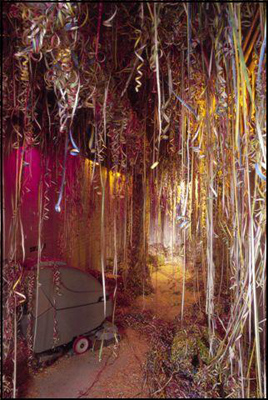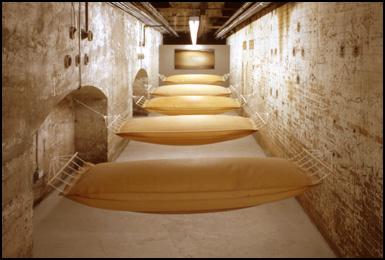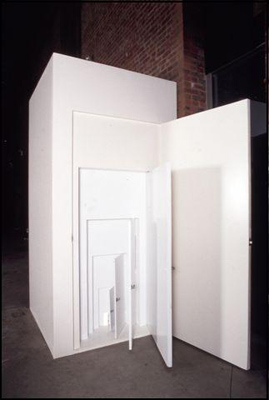Show Space: Curating Art in and from East Central Europe
Architectures of Gender. Contemporary Women’s Art in Poland. SculptureCenter, Long Island City, New York, 11.04. – 8.06. 2003
(www.sculpture-center.org; www.polishculture-nyc.org)
Participating artists: Izabella Gustowska, Elzbieta Jablonska, Katarzyna Jozefowicz, Agnieszka Kalinowska, Katarzyna Kozyra, Zofia Kulik, Natalia LL, Dorota Nieznalska, Hanna Nowicka-Grochal, Paulina Olowska, Anna Plotnicka, Jadwiga Sawicka, Dominika Skutnik, Monika Sosnowska, Julita Wojcik, Karolina Wysocka.
In this new series, curators from East-Central Europe talk about recent exhibition projects. We begin the series with a report by Aneta Szylak (gdansk) on her recent project Constructing Architectures of Gender. Aneta Szylak, curator based in Gdansk, Vice-President of the Wyspa Progress Foundation, a non-profit organization established in 1994. In 1998 Ms. Szylak founded the Center for Contemporary Art Laznia (The Bathhouse) and was its director until spring 2001. Curated several shows, i.e.: “Architectures of Gender” [2003], “All you need is love” [2000], “Public Relations” [1999]; “Where are you from?” [1998]. She co-edited a book “The Site of Idea. The Idea of Site” [1995]. Has written numerous texts published in i.e.: Art Journal, n.paradoxa, Praesens.
Commissioned to curate the Polish exhibition in one of the New York art institutions, I faced the wide range of problems associated with the preparation of show that is geographically, nationally, and gender defined.
That means that it may become also politically defined. And if so, how might this may reflect the expectations toward people from our part of Europe in general? Do we really want to fulfill the expectations, to confirm the established vision or to struggle against it?
Are we going to take a stance or to play the strategy? This is one of the general issues involved in being a curator from Central Europe, shaped by certain geographical, political, historical, and artistic contexts. And probably that is why Architectures of Gender. Contemporary Women’s Art in Poland, an exhibition I curated for the SculptureCenter in New York in Spring 2003, was the project that played or circumnavigated some of the components delineated by the title.
The aim was to create the channel for art from Poland, barely known in New York, and to make it a part of the wider artistic discourse, without playing the Central-European exotics and breaking through the clichés about “Polish feminism.”
It was an endeavor to target beyond national representation and to serve as a means of translation between the cultural paradigms of Central Europe and of New York.
It reflected on the Western strategies of exhibition making, the notion of the gallery space, and the spatial aspects of the gender issues settled in the recent cultural, social, and political context.
It related to the current political situation (Numbers by Jadwiga Sawicka) and played with ambiguous messages of the household chores strategically used by women artists like Elzbieta Jablonska in Through the Stomach to the Heart, Anna Plotnicka in Living stories, and Julita Wojcik in My Garden.
I designed the show especially for the SculptureCenter’s new facility and conceived the show as a form of dialogue with the institution’s new exhibition venue.
The roots of the show contain my first emotional and sensual experience of the building I found to be both “the body” and “the structure.” The “body” had a deep impact on my own through its presence, motion, and its absorption of the sensual and material density of the space.
The massive, humid, and dark space gave birth to the different mental and bodily emotions and experiences referring to masculinity and sexuality as well as to the history of the industrial art spaces and the male/female relationships.
The structure of the building made me think not only about the architecture and construction but also about the entire message of the space, reflecting the strategies of industrialism, modernity, and progress.
From combination of these two ideas came the third – the consideration of the social construction of gender in the context of this particular building.
The show reflected on the history of the former industrial spaces in USA turned into art venues, traditionally associated with masculinity and minimalist a esthetics.
The space was conquered with a variety of unusual materials, transforming the space functionally end a esthetically (Agnieszka Kalinowska’s Just a little bit more , Dominika Skutnik’s The Field).
The idea was to capture the complexity of the issues generated by the space in the moment of functional, aesthetic and intellectual transition.
Karolina Wysocka’s Cautiously installation, the set of the museum stanchions entirely made of glass, was not only controlling the viewer’s body and behavior, but also controlled the perception.
Located at the end of the show and leading to the exit, the poles shaped either in phallic or vulva-like forms indicated the fragility of the gendered cultural discourse and the role of the museum in it.
Reinterpreted, described, transformed, constructed, or deconstructed by sixteen Polish women artists, the SculptureCenter’s spectacular new venue provided the viewer with an exceptional — both intellectual and sensual — experience.
Hanna Nowicka Grochal’s The Pleasure out of Reach , Izabella Gustowska’s Passions and Other Cases, Natalia LL’s Allusive Space or Zofia Kulik’s The World as War and Adornment along with works by Katarzyna Kozyra and Dorota Nieznalska focused more on the representation of the masculine body.
<pclass=”body”>Relating to the message of the building, the exhibition reflected on the issues of masculinity and sexuality seen from the women’s point of view and experimented with stimulating all of the viewer’s senses.
The importance of the viewer’s gendered presence within was crucial for the exhibition. Personalization of the perception and focus on the individual’s experience was inscribed in the concept of show.
I tried to impart some part of my own experience into the one projected on the viewer’s body. The tradition of modernity, the one both Western and Eastern paradigms share, was a navigating tool for the show, recalling the memory of the Central European Avant-Garde, the ideal of the white cube (Perriand by Paulina Olowska), the search for “non-neutral” exhibition space, and the utopias of social housing projects (Monika Sosnowska’s Entrance and Katarzyna Jozefowicz’s Habitat).
The notion of architecture in this exhibition title recalled my impression of the building, but also referred to some other gendered spaces and the bodily experience within them (Dorota Nieznalska’s Omnipotence. Gender: Male and Katarzyna Kozyra’s The Men’s Bathhouse).
But it was also expanded to reflect the means of cultural and social constructions of gender, specific to the local experience of the artists. It also tried to rebuild the missing link of the individual’s experience, beyond borders, political implications and the clichés of perception.








